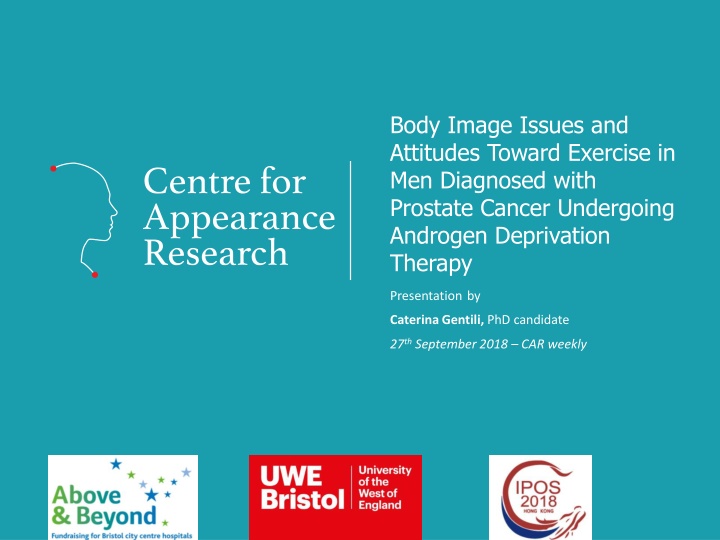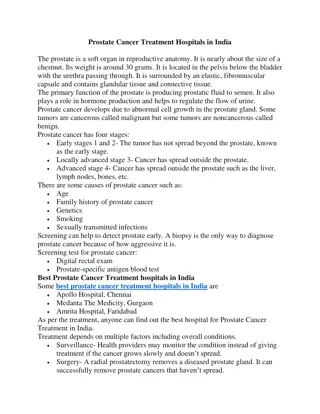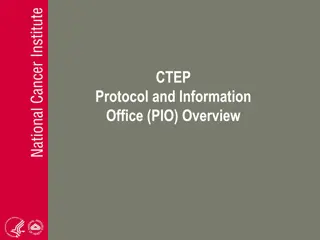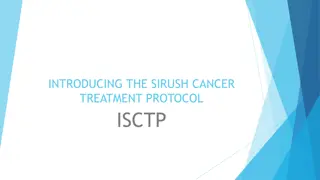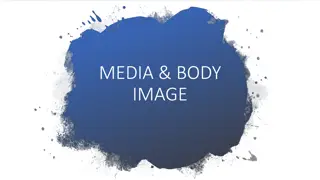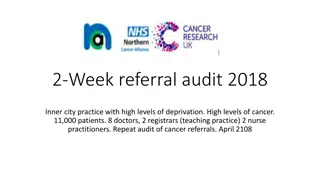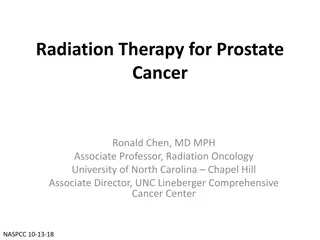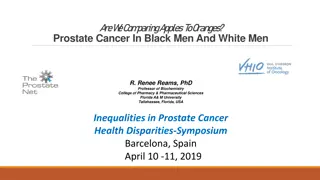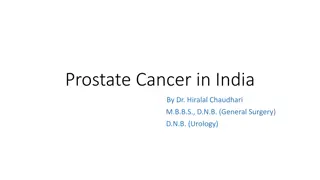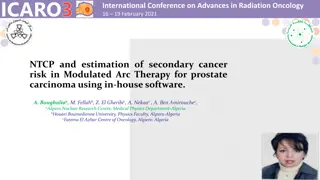Body Image and Exercise Attitudes in Men with Prostate Cancer Undergoing Androgen Deprivation Therapy
The presentation by Caterina Gentili, PhD candidate, on body image issues and exercise attitudes in men diagnosed with prostate cancer undergoing androgen deprivation therapy sheds light on the challenges faced by this population. The background discusses the increasing number of prostate cancer survivors and the significance of androgen deprivation therapy as a standard treatment. The therapy, while effective in slowing cancer growth, brings about various side effects affecting quality of life, sexuality, and body image. Patients are encouraged to seek psychological help to cope with these challenges.
Download Presentation

Please find below an Image/Link to download the presentation.
The content on the website is provided AS IS for your information and personal use only. It may not be sold, licensed, or shared on other websites without obtaining consent from the author.If you encounter any issues during the download, it is possible that the publisher has removed the file from their server.
You are allowed to download the files provided on this website for personal or commercial use, subject to the condition that they are used lawfully. All files are the property of their respective owners.
The content on the website is provided AS IS for your information and personal use only. It may not be sold, licensed, or shared on other websites without obtaining consent from the author.
E N D
Presentation Transcript
Body Image Issues and Attitudes Toward Exercise in Men Diagnosed with Prostate Cancer Undergoing Androgen Deprivation Therapy Presentation by Caterina Gentili, PhD candidate 27thSeptember 2018 CAR weekly
Background growing population of PCa survivors
Background growing population of PCa survivors Androgen Deprivation Therapy (ADT)
Background growing population of PCa survivors Androgen Deprivation Therapy (ADT) Gold standard treatment Received by 50% of PCa patients (Chen et al., 2014; Ferlay et al., 2018)
Androgen Deprivation Therapy Slowing cancer growth
Androgen Deprivation Therapy Slowing cancer growth Side effects: - Weight gain - Loss of muscle mass - Breast enlargement - Penile and testicular shrinkage - Lack of libido - Impotence - Incontinence - Hot flushes - Fatigue Etc.
Androgen Deprivation Therapy Slowing cancer growth Side effects: - Weight gain - Loss of muscle mass - Breast enlargement - Penile and testicular shrinkage - Lack of libido - Impotence - Incontinence - Hot flushes - Fatigue Etc. Quality of life Sexuality Body Image (Harrington, Jones, E. G., & Badger, T., 2009)
What can patients do about it? Seek psychological help?
What can patients do about it? Awareness? Access? Acceptability? Seek psychological help?
What can patients do about it? Awareness? Access? Acceptability? Seek psychological help? Practical coping strategy: exercise?
What can patients do about it? Awareness? Access? Acceptability? Seek psychological help? Practical coping strategy: exercise? Physical health survival muscular and skeletal strength cardiorespiratory outcomes sexual functioning cancer progression fatigue cholesterol
What can patients do about it? Awareness? Access? Acceptability? Seek psychological help? Practical coping strategy: exercise? Psychological health quality of life masculine identity control over ADT side effects body satisfaction appearance satisfaction physical self efficacy stress management Physical health survival muscular and skeletal strength cardiorespiratory outcomes sexual functioning cancer progression fatigue cholesterol
What can patients do about it? Awareness? Access? Acceptability? Seek psychological help? Low adherence rates: 30% aerobic exercise 14% strength exercise Practical coping strategy: exercise? Psychological health quality of life masculine identity control over ADT side effects body satisfaction appearance satisfaction physical self efficacy stress management Physical health survival muscular and skeletal strength cardiorespiratory outcomes sexual functioning cancer progression fatigue cholesterol
Aims Further explore the impact of ADT-induced appearance and functionality changes on patients body image.
Aims Further explore the impact of ADT-induced appearance and functionality changes on patients body image. Investigate patients attitudes towards exercise and potential exercise barriers.
Methods Participants 22 men diagnosed with PCa ADT at least once in their life Mage = 67.9 yo, SD = 9.99 Recruited through charities, social media, UWE press release
Methods Participants 22 men diagnosed with PCa ADT at least once in their life Mage = 67.9 yo, SD = 9.99 Recruited through charities, social media, UWE press release 22 Semi structured interviews 30 - 50 min. 13 phone 9 face to face audio recorded transcribed verbatim
Methods Topics ADT-induced bodily changes Body image issues Masculinity Exercise
Methods Topics ADT-induced bodily changes Body image issues Masculinity Exercise Analyses Thematic analysis NVivo
Results: main themes Body feminization I was somehow convinced that I was turning into a woman. Enrico
Breast enlargement Results: main themes It s embarrassing. I remember having the grankid saying shouting to his sister my grandad got boobies! you know which is not nice you know Carlo Body feminization I was somehow convinced that I was turning into a woman. Enrico
Breast enlargement Results: main themes It s embarrassing. I remember having the grankid saying shouting to his sister my grandad got boobies! you know which is not nice you know Carlo Weight gain Body feminization I feel I am looking fatter as well as feeling fatter emh I don t want to be carrying all this extra weight around with me when I do that I was somehow convinced that I was turning into a woman. Edoardo Enrico
Breast enlargement Results: main themes It s embarrassing. I remember having the grankid saying shouting to his sister my grandad got boobies! you know which is not nice you know Carlo Weight gain Body feminization I feel I am looking fatter as well as feeling fatter emh I don t want to be carrying all this extra weight around with me when I do that I was somehow convinced that I was turning into a woman. Edoardo Enrico Functionality loss Now my energy levels aren t as great as they used to be. Before I was able to walk 15 to 20 miles a day. But those days have gone now and I found that very sad. Giovanni
Breast enlargement Results: main themes It s embarrassing. I remember having the grankid saying shouting to his sister my grandad got boobies! you know which is not nice you know Carlo Weight gain Body feminization I feel I am looking fatter as well as feeling fatter emh I don t want to be carrying all this extra weight around with me when I do that I was somehow convinced that I was turning into a woman. Edoardo Enrico Functionality loss Now my energy levels aren t as great as they used to be. Before I was able to walk 15 to 20 miles a day. But those days have gone now and I found that very sad. Sexual issues It s upset is uncomfortable, it s upset. ( ) Obviously the physical side of our relationship is not totally fulfilled Giovanni Giovanni
Results: main themes Exercise
Counterbalance ADT Regular exercise does help to keep your weight down Results: main themes Ludovico Exercise
Counterbalance ADT Regular exercise does help to keep your weight down Results: main themes Ludovico Achievement and control You are under still a little bit of control (..) I don t know how long I have got but it s just gratifying and reassuring that I can still do things Exercise Michele
Counterbalance ADT Regular exercise does help to keep your weight down Results: main themes Ludovico Achievement and control You are under still a little bit of control (..) I don t know how long I have got but it s just gratifying and reassuring that I can still do things Exercise Michele Time and energy levels I am working full time, and you are tired after work. It is difficult to fit exercise in your day Mario
Counterbalance ADT Regular exercise does help to keep your weight down Results: main themes Ludovico Achievement and control You are under still a little bit of control (..) I don t know how long I have got but it s just gratifying and reassuring that I can still do things Exercise Michele Time and energy levels I am working full time, and you are tired after work. It is difficult to fit exercise in your day Mario Fear of negative evaluation You got somebody else in front of you or next to you and you still think Oh they are quicker! Paolo
Conclusions ADT side effects can have an impact on patients body image and masculine identity
Conclusions ADT side effects can have an impact on patients body image and masculine identity Body image issues are mostly dependent on body feminization
Conclusions ADT side effects can have an impact on patients body image and masculine identity Body image issues are mostly dependent on body feminization Physically active patients find an effective coping strategy in exercise
Conclusions ADT side effects can have an impact on patients body image and masculine identity Body image issues are mostly dependent on body feminization Physically active patients find an effective coping strategy in exercise Future directions I will further explore the topic quantitatively Some patients might benefit from information and support for body image concerns Patients who are not physically active might benefit from an exercise intervention
References Alleva, J. M., Martijn, C., Jansen, A., & Nederkoorn, C. (2014). Body language: Affecting body satisfaction by describing the body in functionality terms. Psychology of Women Quarterly, 38(2), 181-196. Appleton, L., Wyatt, D., Perkins, E., Parker, C., Crane, J., Jones, A., . . . Pagett, M. (2015). The impact of prostate cancer on men's everyday life. European journal of cancer care, 24(1), 71-84. Beauchamp, M. R., Carron, A. V., McCutcheon, S., & Harper, O. (2007). Older adults' preferences for exercising alone versus in groups: Considering contextual congruence. Annals of Behavioral Medicine, 33(2), 200-206. Braun, V., & Clarke, V. (2006). Using thematic analysis in psychology. Qualitative research in psychology, 3(2), 77-101. Chapple, A., & Ziebland, S. (2002). Prostate cancer: embodied experience and perceptions of masculinity. Sociology of Health & Illness, 24(6), 820-841. Chen, R. C., Hamstra, D. A., Sandler, H. M., & Zietman, A. L. (2014). Complications of prostate cancer treatment. The Lancet Oncology, 15(4), e150. Craike, M. J., Livingston, P. M., & Botti, M. (2009). How much do we know about the determinants of physical activity among prostate cancer survivors? Directions for future research to inform interventions. Australian and New Zealand journal of public health, 33(2), 193-194. Craike, M. J., Livingston, P. M., & Botti, M. (2011). An exploratory study of the factors that influence physical activity for prostate cancer survivors. Supportive Care in Cancer, 19(7), 1019-1028. Dall Era, M. A., Albertsen, P. C., Bangma, C., Carroll, P. R., Carter, H. B., Cooperberg, M. R., . . . Soloway, M. S. (2012). Active surveillance for prostate cancer: a systematic review of the literature. European urology, 62(6), 976-983. Ervik, B., & Asplund, K. (2012). Dealing with a troublesome body: A qualitative interview study of men s experiences living with prostate cancer treated with endocrine therapy. European Journal of Oncology Nursing, 16(2), 103-108. Ferlay, J., Colombet, M., Soerjomataram, I., Dyba, T., Randi, G., Bettio, M., . . . Bray, F. (2018). Cancer incidence and mortality patterns in Europe: Estimates for 40 countries and 25 major cancers in 2018. European Journal of Cancer. Forbes, C. C., Blanchard, C. M., Mummery, W. K., & Courneya, K. S. (2015). Prevalence and correlates of strength exercise among breast, prostate, and colorectal cancer survivors. Paper presented at the Oncol Nurs Forum. Fowler, F. J., McNaughton Collins, M., Walker Corkery, E., Elliott, D. B., & Barry, M. J. (2002). The impact of androgen deprivation on quality of life after radical prostatectomy for prostate carcinoma. Cancer, 95(2), 287-295. Galdas, P. M., Cheater, F., & Marshall, P. (2005). Men and health help seeking behaviour: literature review. Journal of advanced nursing, 49(6), 616-623. Glode, L. M., Tangen, C. M., Hussain, M., Swanson, G. P., Wood, D. P., Sakr, W., . . . Dorff, T. B. (2017). Adjuvant androgen deprivation (ADT) versus mitoxantrone plus prednisone (MP) plus ADT in high-risk prostate cancer (PCa) patients following radical prostatectomy: A phase III intergroup trial (SWOG S9921) NCT00004124. In: American Society of Clinical Oncology. Graham, J., Kirkbride, P., Cann, K., Hasler, E., & Prettyjohns, M. (2014). Prostate cancer: summary of updated NICE guidance. BMJ: British Medical Journal (Online), 348. Harrington, J. M., & Badger, T. A. (2009). Body image and quality of life in men with prostate cancer. Cancer nursing, 32(2), E1-E7. Harrington, J. M., Jones, E. G., & Badger, T. (2009). Body image perceptions in men with prostate cancer. Paper presented at the Oncology nursing forum. Hyde, M., Newton, R., Galvao, D. A., Gardiner, R., Occhipinti, S., Lowe, A., . . . Chambers, S. K. (2017). Men's help seeking in the first year after diagnosis of localised prostate cancer. European journal of cancer care, 26(2).
Hyde, M. K., Zajdlewicz, L., Wootten, A. C., Nelson, C. J., Lowe, A., Dunn, J., & Chambers, S. K. (2016). Medical help-seeking for sexual concerns in prostate cancer survivors. Sexual medicine, 4(1), e7-e17. Kelly, D. (2009). Changed men: The embodied impact of prostate cancer. Qualitative Health Research, 19(2), 151-163. Keogh, J. W., Patel, A., MacLeod, R. D., & Masters, J. (2013). Perceptions of physically active men with prostate cancer on the role of physical activity in maintaining their quality of life: possible influence of androgen deprivation therapy. Psycho Oncology, 22(12), 2869- 2875. Keogh, J. W., Patel, A., MacLeod, R. D., & Masters, J. (2014). Perceived barriers and facilitators to physical activity in men with prostate cancer: possible influence of androgen deprivation therapy. European journal of cancer care, 23(2), 263-273. Keogh, J. W., Shepherd, D., Kr geloh, C. U., Ryan, C., Masters, J., Shepherd, G., & MacLeod, R. (2010). Predictors of physical activity and quality of life in New Zealand prostate cancer survivors undergoing androgen-deprivation therapy. The New Zealand Medical Journal (Online), 123(1325). Kunkel, E. J., Bakker, J. R., Myers, R. E., Oyesanmi, O., & Gomella, L. G. (2000). Biopsychosocial aspects of prostate cancer. Psychosomatics, 41(2), 85-94. Langelier, D. M., Cormie, P., Bridel, W., Grant, C., Albinati, N., Shank, J., . . . Culos-Reed, S. N. (2018). Perceptions of masculinity and body image in men with prostate cancer: the role of exercise. Supportive Care in Cancer, 1-10. Makarov, D. V., Humphreys, E. B., Mangold, L. A., Carducci, M. A., Partin, A. W., Eisenberger, M. A., . . . Trock, B. J. (2008). The natural history of men treated with deferred androgen deprivation therapy in whom metastatic prostate cancer developed following radical prostatectomy. The Journal of urology, 179(1), 156-162. Meng, M. V., Grossfeld, G. D., Sadetsky, N., Mehta, S. S., Lubeck, D. P., & Carroll, P. R. (2002). Contemporary patterns of androgen deprivation therapy use for newly diagnosed prostate cancer. Urology, 60(3), 7-11. Menzel, J. E., Krawczyk, R., & Thompson, J. K. (2011). Attitudinal assessment of body image for adolescents and adults. Body image: a handbook of science, practice, and prevention, 2, 154-169. Navon, L., & Morag, A. (2003). Advanced prostate cancer patients ways of coping with the hormonal therapy s effect on body, sexuality, and spousal ties. Qualitative Health Research, 13(10), 1378-1392. Palinkas, L. A., Horwitz, S. M., Green, C. A., Wisdom, J. P., Duan, N., & Hoagwood, K. (2015). Purposeful sampling for qualitative data collection and analysis in mixed method implementation research. Administration and Policy in Mental Health and Mental Health Services Research, 42(5), 533-544. Rock, C. L., Doyle, C., Demark Wahnefried, W., Meyerhardt, J., Courneya, K. S., Schwartz, A. L., . . . McCullough, M. (2012). Nutrition and physical activity guidelines for cancer survivors. CA: a cancer journal for clinicians, 62(4), 242-274. Smith, J. A. (2007). Beyond masculine stereotypes: Moving men's health promotion forward in Australia. Health promotion journal of Australia, 18(1), 20-25. Smith, M. R., Finkelstein, J. S., McGovern, F. J., Zietman, A. L., Fallon, M. A., Schoenfeld, D. A., & Kantoff, P. W. (2002). Changes in body composition during androgen deprivation therapy for prostate cancer. The Journal of Clinical Endocrinology & Metabolism, 87(2), 599-603. Tewari, A., Sooriakumaran, P., Bloch, D. A., Seshadri-Kreaden, U., Hebert, A. E., & Wiklund, P. (2012). Positive surgical margin and perioperative complication rates of primary surgical treatments for prostate cancer: a systematic review and meta-analysis comparing retropubic, laparoscopic, and robotic prostatectomy. European urology, 62(1), 1-15.
Thompson, I. M., Tangen, C. M., Paradelo, J., Lucia, M. S., Miller, G., Troyer, D., . . . Swanson, G. (2009). Adjuvant radiotherapy for pathological T3N0M0 prostate cancer significantly reduces risk of metastases and improves survival: long-term followup of a randomized clinical trial. The Journal of urology, 181(3), 956-962. Thorsen, L., Courneya, K. S., Stevinson, C., & Foss , S. D. (2008). A systematic review of physical activity in prostate cancer survivors: outcomes, prevalence, and determinants. Supportive Care in Cancer, 16(9), 987-997. Torre, L. A., Siegel, R. L., Ward, E. M., & Jemal, A. (2016). Global cancer incidence and mortality rates and trends an update. Cancer Epidemiology and Prevention Biomarkers, 25(1), 16-27. Tylka, T. L., & Wood-Barcalow, N. L. (2015). What is and what is not positive body image? Conceptual foundations and construct definition. Body image, 14, 118-129. Vogel, D. L., Heimerdinger-Edwards, S. R., Hammer, J. H., & Hubbard, A. (2011). Boys don't cry : Examination of the links between endorsement of masculine norms, self-stigma, and help-seeking attitudes for men from diverse backgrounds. Journal of Counseling Psychology, 58(3), 368. Walker, L. M., Tran, S., & Robinson, J. W. (2013). Luteinizing hormone releasing hormone agonists: a quick reference for prevalence rates of potential adverse effects. Clinical genitourinary cancer, 11(4), 375-384.
